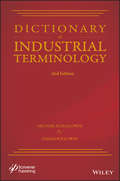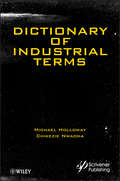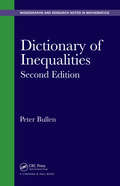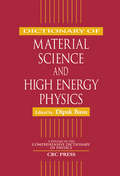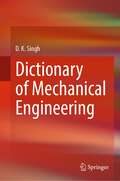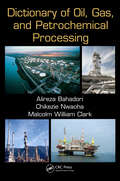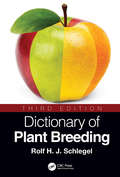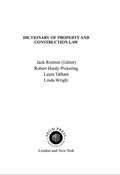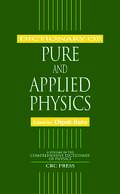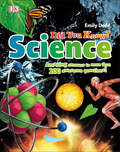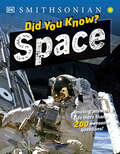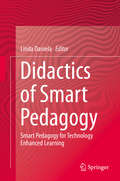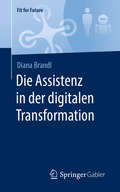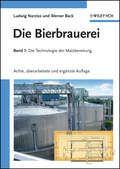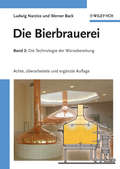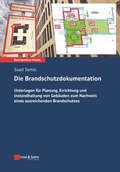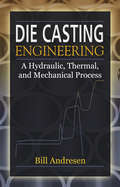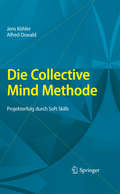- Table View
- List View
Dictionary of Industrial Terminology
by Michael D. Holloway Emma HollowayThis is the most comprehensive dictionary of maintenance and reliability terms ever compiled, covering the process, manufacturing, and other related industries, every major area of engineering used in industry, and more. The over 15,000 entries are all alphabetically arranged and include special features to encourage usage and understanding. They are supplemented by hundreds of figures and tables that clearly demonstrate the principles & concepts behind important process control, instrumentation, reliability, machinery, asset management, lubrication, corrosion, and much much more.With contributions by leading researchers in the field:Zaki Yamani Bin Zakaria Department, Chemical Engineering, Faculty Universiti Teknologi Malaysia, Malaysia Prof. Jelenka B. Savkovic-Stevanovic, Chemical Engineering Dept, University of Belgrade, Serbia Jim Drago, PE, Garlock an EnPro Industries family of companies, USA Robert Perez, President of Pumpcalcs, USA Luiz Alberto Verri, Independent Consultatnt, Verri Veritatis Consultoria, Brasil Matt Tones, Garlock an EnPro Industries family of companies, USA Dr. Reza Javaherdashti, formerly with Qatar University, Doha-Qatar Prof. Semra Bilgic, Faculty of Sciences, Department of Physical Chemistry, Ankara University, Turkey Dr. Mazura Jusoh , Chemical Engineering Department, Universiti Teknologi Malaysia Jayesh Ramesh Tekchandaney, Unique Mixers and Furnaces Pvt. Ltd. Dr. Henry Tan, Senior Lecturer in Safety & Reliability Engineering, and Subsea Engineering, School of Engineering, University of Aberdeen Fiddoson Fiddo, School of Engineering, University of Aberdeen Prof. Roy Johnsen, NTNU, Norway Prof. N. Sitaram , Thermal Turbomachines Laboratory, Department of Mechanical Engineering, IIT Madras, Chennai India Ghazaleh Mohammadali, IranOilGas Network Members' Services Greg Livelli, ABB Instrumentation, Warminster, Pennsylvania, USA Gas Processors Suppliers Association (GPSA)
Dictionary of Industrial Terms
by Chikezie Nwaoha Michael D. HollowayThis is the most comprehensive dictionary of maintenance and reliability terms ever compiled, covering the process, manufacturing, and other related industries, every major area of engineering used in industry, and more. The over 15,000 entries are all alphabetically arranged and include special features to encourage usage and understanding. They are supplemented by hundreds of figures and tables that clearly demonstrate the principles & concepts behind important process control, instrumentation, reliability, machinery, asset management, lubrication, corrosion, and much much more.With contributions by leading researchers in the field:Zaki Yamani Bin Zakaria Department, Chemical Engineering, Faculty Universiti Teknologi Malaysia, Malaysia Prof. Jelenka B. Savkovic-Stevanovic, Chemical Engineering Dept, University of Belgrade, Serbia Jim Drago, PE, Garlock an EnPro Industries family of companies, USA Robert Perez, President of Pumpcalcs, USA Luiz Alberto Verri, Independent Consultatnt, Verri Veritatis Consultoria, Brasil Matt Tones, Garlock an EnPro Industries family of companies, USA Dr. Reza Javaherdashti, formerly with Qatar University, Doha-Qatar Prof. Semra Bilgic, Faculty of Sciences, Department of Physical Chemistry, Ankara University, Turkey Dr. Mazura Jusoh , Chemical Engineering Department, Universiti Teknologi Malaysia Jayesh Ramesh Tekchandaney, Unique Mixers and Furnaces Pvt. Ltd. Dr. Henry Tan, Senior Lecturer in Safety & Reliability Engineering, and Subsea Engineering, School of Engineering, University of Aberdeen Fiddoson Fiddo, School of Engineering, University of Aberdeen Prof. Roy Johnsen, NTNU, Norway Prof. N. Sitaram , Thermal Turbomachines Laboratory, Department of Mechanical Engineering, IIT Madras, Chennai India Ghazaleh Mohammadali, IranOilGas Network Members' Services Greg Livelli, ABB Instrumentation, Warminster, Pennsylvania, USA Gas Processors Suppliers Association (GPSA)
Dictionary of Inequalities (Chapman & Hall/CRC Monographs and Research Notes in Mathematics)
by Peter BullenAdding new results that have appeared in the last 15 years, Dictionary of Inequalities, Second Edition provides an easy way for researchers to locate an inequality by name or subject. This edition offers an up-to-date, alphabetical listing of each inequality with a short statement of the result, some comments, references to related inequalities, an
Dictionary of Material Science and High Energy Physics
by Dipak BasuMore than 3,000 terms with clear, working definitions, alternative meanings, and related references comprise this uniquely focused lexicon. Published in a convenient, paperback format, it covers chemical, energy, nuclear, plasma, condensed matter, and solid-state physics, fluid dynamics, quantum mechanics, quantum optics, thermodynamics, and materials science.
Dictionary of Mechanical Engineering
by D. K. SinghThis book contains important words and terminologies of the core subjects in mechanical engineering such as engineering mechanics, strength of materials, fluid mechanics, thermodynamics, IC engines, heat and mass transfer, refrigeration and air-conditioning, manufacturing processes, theory of machines, industrial engineering and management, electric vehicles, etc. that are explained in a concise and lucid manner. The contents also touch upon some terminologies of basic science subjects. This dictionary is an easy-to-use and a practical resource which will be highly useful for undergraduate and postgraduate students, researchers, and industry professionals in the field of mechanical engineering.
Dictionary of Nutraceuticals and Functional Foods
by Michael Eskin Snait TamirHealth professionals are recognizing the major role that nutraceuticals play in health enhancement. As a result, there is a dramatic increase in research aimed at identifying new functional foods and nutraceuticals. There is not, however, a single source that presents this research in a thorough and accessible manner. Comprehensive and complete, th
Dictionary of Oil, Gas, and Petrochemical Processing
by Alireza Bahadori Chikezie Nwaoha Malcolm William ClarkIn industry, miscommunication can cause frustration, create downtime, and even trigger equipment failure. By providing a common ground for more effective discourse, the Dictionary of Oil, Gas, and Petrochemical Processing can help eliminate costly miscommunication.An essential resource for oil, gas, and petrochemical industry professionals, enginee
Dictionary of Plant Breeding
by Rolf H. SchlegelOne of the oldest scientific traditions, plant breeding began in Neolithic times with methods as simple as saving the seeds of desirable plants and sowing them later. It was not until the re-encounter with Mendel’s discoveries thousands of years later, the genetic basis of breeding was understood. Developments following have provided further insight into how genes acting alone or in concert with other genes and the environment, result in a particular phenotype. From Abaxial to Zymogram, the third edition of Dictionary of Plant Breeding contains clear and useful definitions of the terms associated with plant breeding and related scientific/technological disciplines. It defines jargon; provides helpful tables, examples, and breeding schemes; and includes a list of crop plants with salient details. Packed with data and organized to make that data easy to access, this revised and expanded reference provides comprehensive coverage of the latest discoveries in cytogenetics, molecular genetics, marker-assisted selection, experimental gene transfer, CRISPR technology, seed sciences, crop physiology, and genetically modified crops. Features: Provides a comprehensive list of technical terms used in plant breeding Explores the historical development of crop improvement Discusses applications of molecular genetics and biotechnology Includes numerous figures, drawings, tables, and schemes supplementing the glossary A complex subject, plant breeding draws from many scientific and technological disciplines, often making it difficult to know the precise meanings of many terms and to accurately interpret specific concepts. As in the previous editions, this dictionary unifies concepts by including the specific terms of plant breeding and terms that are adjusted from other disciplines. Drawing on Rolf Schlegel’s 50 years of experience, the book provides an encyclopedic list of commonly used technical terms that reflect the latest developments in the field.
Dictionary of Property and Construction Law
by Linda Wright J. Rostron Robert Hardy-Pickering Laura TathamThis is a new dictionary which provides a clear and concise explanation of terms used in land, property and construction law and management. The four key areas of coverage are: planning/construction law, land law, equity/trusts and finance and administration. It will be a useful reference for property and building professionals and a personal purchase for students of property and construction law on building, construction management, estate management and law courses.Jack Rostron is an experienced author and editor whose 1997 Spon title Sick Building Syndrome has been well received and widely reviewed. His co-authors contribute the necessary specialist knowledge from their respective fields of teaching and legal practice.
Dictionary of Pure and Applied Physics
by Dipak BasuClear, precise definitions of scientific terms are crucial to good scientific and technical writing-and to understanding the writings of others. Whether you are a physicist, engineer, mathematician, or technical writer, whether you work in a research, academic, or industrial setting, we all have the occasional need for comprehensible, working definitions of scientific terms. To meet that need, CRC Press proudly announces publication of the Dictionary of Pure and Applied Physics-the first published volume of CRC's Comprehensive Dictionary of Physics. Authored by eminent scientists from around the world, offers concise, authoritative definitions of more than 3,000 terms covering a range of pure and applied disciplines: acoustics biophysics communications electricity electronics geometrical optics low-temperature physics magnetism medical physics physical optics The editor has taken care to ensure each entry is as self-contained as possible, to include terms from the frontiers of technology, and to omit obsolete terms that can clutter a search. The result is a lucid, accessible, and convenient reference valuable to both the novice and the seasoned professional.
Did You Know? Science (Why? Series)
by DKSatisfy your curious budding scientist with a book that explains the way we explain everything else. It all comes down to Science!Learn about a range of subjects that tell us about everything. From earth science and biology, to energy, physics, and astronomy. We give the answers to the questions kids aged 7-10 really want to know about in easy-to-follow question and answer format.This book focuses on the subjects that kids really want to know about and the questions they ask. Every question is answered with a detailed explanation, rich illustrations, and easy to understand text that will ease the curiosity of young minds. From earth science and biology to energy, physics, and astronomy. Did You Know? Science makes learning the science behind everyday matters easy to understand, fun, and engaging.Answers to over 200 questions about the living world, the human body, the material world, energy, forces, movement, and our planet. Described in colorful pages and in a fun question-and-answer format. Designed for ages 5-9 and organized into easy to understand bite-size nuggets of information.Fantastic Facts For Curious Minds!Did You Know? Science answers all the amazing questions children have about science, from how lights turn on and what makes cars go, to what makes the Earth look blue and how people move! This colorful and exciting book is full of awesome pictures and incredible facts about magnets, fossils, the human body, our planet, and much more!This is the ideal science encyclopedia to help your budding Einstein, as well as for parents who need to answer those tricky science questions sparked by curiosity. &“Where does light come from? Can I feel forces? What is my body made of?&”This amazing science book will answer interesting questions about:- The Living World- The Human Body- The Material World- Energy- Our Planet- Forces And MovementDid You Know? Science: Amazing Answers To More Than 200 Awesome Questions is part of the educational series Did You Know? Encyclopedias. Complete the collection and learn more about the world around you and the questions you ask, science, and space.
Did You Know? Space (Why? Series)
by DKThis fact-filled space ebook features amazing pictures from NASA and asks questions such as: Why is Jupiter striped? Is there life on Mars?The ebook includes the latest space exploration news and is perfect for young space fans as well as children new to the subject. Covering the solar system, stars, galaxies, and space exploration, the ebook has clear and simple text, and information that is utterly fascinating for this age range. Did You Know? Space is the ideal ebook on the amazing universe for kids.
Didactics of Smart Pedagogy: Smart Pedagogy for Technology Enhanced Learning
by Linda DanielaThe focus on smart education has become a new trend in the global educational field. Some countries have already developed smart education systems and there is increasing pressure coming from business and tech communities to continue this development. Simultaneously, there are only fragmented studies on the didactic aspects of technology usage. Thus, pedagogy as a science must engage in a new research direction—smart pedagogy. This book seeks to engage in a new research direction, that of smart pedagogy. It launches discussions on how to use all sorts of smart education solutions in the context of existing learning theories and on how to apply innovative solutions in order to reduce the marginalization of groups in educational contexts. It also explores transformations of pedagogical science, the role of the educator, applicable teaching methods, learning outcomes, and research and assessment of acquired knowledge in an effort to make the smart education process meaningful to a wide audience of international educators, researchers, and administrators working within and tangential to TEL.
Diddly Squat: From Sunday Times bestselling author and Grand Tour presenter (Diddly Squat)
by Jeremy ClarksonIt's been another memorable year on Diddly Squat Farm - will the chickens finally come home to roost?Welcome back to Clarkson’s Farm . . .Where the spring barley crop has failed. Just like the oil seed rape. And the oats turned the colour of a hearing aid. The mushrooms went mouldy. While the sheep, pigs and cows cost more than they earned. At least, the farm shop’s doing a roaring trade in candles – even if they smell like Jeremy’s knacker hammock.So never mind the rain, the skirmishes with the local planning department and the gargantuan hole in Jeremy’s wallet. Because it’s hard to feel too gloomy about life when there’s a JCB telehandler, a crop-spraying hovercraft and a digger waiting in the barn.For any man with several metric tons of powerful machinery at his fingertips must be doing something right . . .Number 1 Sunday Times bestseller, October 2024
Diddly Squat: Pigs Might Fly
by Jeremy ClarksonGet tucked in to a third bestselling helping of Clarkson's Farm from our favourite wellie-wearing wannabe farmer, Jeremy ClarksonWelcome back to Clarkson's Farm. Since taking the wheel three years ago Jeremy's had his work cut out. And it's now clear from hard-won experience that, when it comes to farming, there's only one golden rule:Whatever you hope will happen, won't.Enthusiastic schemes to diversify have met with stubborn opposition from the red trouser brigade, defeat at the hands of Council Planning department, and predictable derision from Kaleb - although, to be fair, even Lisa had doubts about Jeremy's brilliant plan to build a business empire founded on rewilding and nettle soup. And only Cheerful Charlie is still smiling about the stifling amount of red tape that's incoming . . . But he charges by the hour.Then there are the animals: the sheep are gone; the cows have been joined by a rented bull called Break-Heart Maestro;. the pigs are making piglets; and the goats have turned out to be psychopaths.But despite the naysayers and (sometimes self-inflicted) setbacks, Jeremy remains irrepressibly optimistic about life at Diddly Squat. Because It's hard not to be when you get to harvest blackberries with a vacuum cleaner.And, after all, it shouldn't just be Break-heart Maestro who gets to enjoy a happy ending . . .Diddly Squat, Number 1 Sunday Times bestseller, October 2022
Diddly Squat: The No 1 Sunday Times Bestseller
by Jeremy ClarksonPull on your wellies, grab your flat cap and join Jeremy Clarkson in this hilarious and fascinating behind-the-scenes look at the infamous Diddly Squat FarmTHE NO. 1 SUNDAY TIMES BESTSELLER'Brilliant . . . laugh-out-loud' Daily Telegraph'Outrageously funny . . . will have you in stitches' Time Out_________Welcome to Clarkson's farm.It's always had a nice ring to it. Jeremy just never thought that one day his actual job would be 'a farmer'.And, sadly, it doesn't mean he's any good at it.From buying the wrong tractor (Lamborghini, since you ask . . .) to formation combine harvesting, getting tied-up in knots of red tape to chasing viciously athletic cows, our hero soon learns that enthusiasm alone might not be enough.Jeremy may never succeed in becoming master of his land, but, as he's discovering, the fun lies in the trying . . ._________'Very funny . . . I cracked up laughing on the tube' Evening StandardPraise for Clarkson's Farm:'The best thing Clarkson's done . . . it pains me to say this' GUARDIAN'Shockingly hopeful' INDEPENDENT'Even the most committed Clarkson haters will find him likeable here' TELEGRAPH'Quite lovely' THE TIMES
Diddly Squat: The No 1 Sunday Times Bestseller 2022
by Jeremy ClarksonTHE NO. 1 SUNDAY TIMES BESTSELLERHead back down to Clarkson Farm with the latest bestseller from our favourite welly-wearing wannabe farmer, Jeremy Clarkson___________Enthusiastic trainee farmer Jeremy Clarkson made just £144 in his first year at Diddly Squat Farm. This year he's determined to do better. Not because he now knows what he's doing. But because he's fed up of getting stick from Kaleb.Yet farming continues to be a challenge.For instance . . .· Loading a grain trailer was more demanding than flying an Apache gunship?· Cows were more dangerous than motor-racing?· It's easier to get planning permission to build a nuclear plant than to turn a barn into a restaurant?Jeremy's always got a plan. Loads of them. Often cunning.Not always greeted with wild enthusiasm by Kaleb and Cheerful Charlie, however . . .___________PRAISE FOR DIDDLY SQUAT'Clarkson has done more for farmers in one series than Countryfile achieved in 30 years' James Rebanks, author of A Shepherd's Life'Clarkson has showcased the passion, humour and personalities of the people who work throughout the year to grow the nation's food . . . and brought an understanding of many of the issues faced by farmers to the British public' National Farmers Union'A deserving Farming Champion of the Year' Farmers Weekly 'I don't know anything about farming. It's like David Attenborough doing jet-skiing, or Nicholas Witchell saying, "I'm going to be a cage fighter'" Jeremy Clarkson
Die 22 kreativen Prinzipien der Evolution: Gezeigt an 6 Disziplinen
by Thomas ServayDas Buch behandelt die Evolution der Kultur bzw. der Disziplinen vom Urknall bis zur Gegenwart. Dazu werden sechs Disziplinen auf 22 gemeinsame kreative Prinzipien hin analysiert und mit systemtheoretischen Grundelementen zu Evolutionsbäumen verbunden. Dies regt zu ganzheitlichem Denken in Systemzusammenhängen an. Es ergibt sich ein Gesamtbild der Evolution von Materie, über Leben und Technik zur Kultur. Zur Beschreibung dieser Entwicklung verwendet Dr. Servay die von ihm abgeleiteten kreativen Prinzipien und zeigt ihr funktionales Auftreten in den sechs Disziplinen Musik, Bildende Kunst, Architektur, Technik, Biologie und Psychologie. Parallel dazu begleiten uns drei Lernstränge über die Kapitel hinweg. Alle drei Stränge werden miteinander verflochten, um die Evolution in einem neuen Licht zu erklären. Bei diesen drei Strängen handelt es sich neben den kreativen Prinzipien um eine didaktisch graduelle Einführung in die Systemtheorie sowie die aus der Biologie bekannten Evolutionslinien. Der Leser wird dadurch in die Lage versetzt, sein persönliches Wissen auf andere Wissensgebiete zu übertragen. Außerdem ermöglichen die Lernstränge, in Systemzusammenhängen zu denken und zu argumentieren. Die aus der Biologie bekannten Abstammungsbäume lassen sich auf andere Disziplinen übertragen. Dies führt in letzter Konsequenz zur Evolution der Disziplinen. Und was könnte unseren Wissensschatz besser repräsentieren als die verschiedenen Disziplinen, die letztendlich unsere Kultur ausmachen?
Die Arena - das Stadion: Geschichte. Entwicklung. Bedeutung. (essentials)
by Mario H. KrausDas Stadion gehört zu den wichtigen Versammlungsorten in Siedlungsräumen. Es steht für den gesellschaftlichen Zweck der geregelten Massenunterhaltung, der in der Moderne umfassend mit zahlreichen Wirtschaftskreisläufen vernetzt ist. Diese kleine Abhandlung beschreibt Besonderheiten, Entwicklung und Bedeutung der Bauform.
Die Assistenz in der digitalen Transformation (Fit for Future)
by Diana BrandlDie Arbeitswelt 4.0 ist vor allem durch die zunehmende Digitalisierung geprägt. Viele Prozesse werden immer stärker digital unterstützt, bis hin zur vollständigen Automatisierung. Das hat Auswirkungen auf das Berufsbild und die Aufgaben der Assistenz und bringt sowohl Herausforderungen als auch Chancen mit sich.Dieses Buch stellt die sich wandelnde Rolle der Assistenz im Office 4.0 und deren gestalterische Möglichkeiten vor. Dazu portraitiert es die Meinungen verschiedener Assistenzen und Entscheider in renommierten Unternehmen, die wertvolle Einblicke in ihren Arbeitsalltag geben. In diesem Zusammenhang werden auch die Technologie der digitalen Assistenten und deren Nutzungsmöglichkeiten im Büroalltag ausführlich beleuchtet und viele praktische Tools vorgestellt, die Arbeit abnehmen und Raum für neue Aufgaben schaffen können. Zahlreiche Beispiele aus der Praxis geben inspirierende Anregungen und zeigen, dass Management-Assistenzen ein wichtiger Treiber der digitalen Transformation sind.Über die Buchreihe "Fit for Future"Die Zukunft wird massive Veränderungen im Arbeits- und Privatleben mit sich bringen. Tendenzen gehen sogar dahin, dass die klassische Teilung zwischen Arbeitszeit und Freizeit nicht mehr gelingen wird. Eine neue Zeit – die sogenannte „Lebenszeit“ – beginnt. Laut Bundesregierung werden in den nächsten Jahren viele Berufe einen tiefgreifenden Wandel erleben und in ihrer derzeitigen Form nicht mehr existieren. Im Gegenzug wird es neue Berufe geben, von denen wir heute noch nicht wissen, wie diese aussehen oder welche Tätigkeiten diese beinhalten werden. Betriebsökonomen schildern mögliche Szenarien, dass eine stetig steigende Anzahl an Arbeitsplätzen durch Digitalisierung und Robotisierung gefährdet sind. Die Reihe „Fit for future“ beschäftigt sich eingehend mit dieser Thematik und bringt zum Ausdruck, wie wichtig es ist, sich diesen neuen Rahmenbedingungen am Markt anzupassen, flexibel zu sein, seine Kompetenzen zu stärken und „Fit for future“ zu werden. Der Initiator der Buchreihe Peter Buchenau lädt hierzu namhafte Experten ein, ihren Erfahrungsschatz auf Papier zu bringen und zu schildern, welche Kompetenzen es brauchen wird, um auch künftig erfolgreich am Markt zu agieren. Ein Buch von der Praxis für die Praxis, von Profis für Profis. Leser und Leserinnen erhalten „einen Blick in die Zukunft“ und die Möglichkeit, ihre berufliche Entwicklung rechtzeitig mitzugestalten.
Die Bierbrauerei: Band 1 - Die Technologie der Malzbereitung
by Ludwig Narziss Werner BackDie lang erwartete, vollstündig überarbeitete Neuauflage des traditionsreichsten Handbuchs der Bierbrauerei bietet sümtliche Grundlagen der modernen Braupraxis, unterteilt in die Bünde "Malzbereitung" und "Würzebereitung". Mit umfangreichem Bild- und Tabellenmaterial.
Die Bierbrauerei: Band 2: Die Technologie der Würzebereitung
by Ludwig Narziss Werner BackDieses Handbuch kombiniert das gesamte Wissen, das fur erfolgreiches Bierbrauen benotigt wird: von der Auswahl der Rohstoffe bis zur garfahigen Wurze. Zahlreiche Tabellen und Abbildungen, die die technischen Details veranschaulichen, machen dieses Buch zum ultimativen Nachschlagewerk. Der Handbuch-Klassiker der beiden beruhmten Bierbrauer Ludwig Narziss und Werner Back liegt endlich uberarbeitet und erganzt als Neuauflage vor.
Die Brandschutzdokumentation: Unterlagen für Planung, Errichtung und Instandhaltung von Gebäuden zum Nachweis eines ausreichenden Brandschutzes (Bauingenieur-Praxis)
by Suad SemicDas vorliegende Buch gibt eine Handlungsanleitung für die Erstellung der Brandschutzdokumentation als umfassende und strukturierte Informationsquelle in allen Lebensphasen eines Gebäudes und hilft sinnvolle Entscheidungen zu treffen. In der Praxis zeigt sich, dass Brandschutzdokumentationen häufig mangelhaft oder unvollständig sind oder gar nicht existieren. Da Sicherheit jedoch an erster Stelle steht und erschöpfend nachgewiesen werden muss, ist dem Brandschutz von Gebäuden besondere Beachtung zu schenken. Die Brandschutzdokumentation im bauordnungsrechtlichen Sinn umfasst alle Unterlagen, die zur Durchführung von Planungs- und Bauleistungen erforderlich sind und im Genehmigungsverfahren, im Zuge der Planung, Bauausführung und Bauabnahme erstellt werden oder vorliegen müssen. Diese sind dem Bauherrn zu übergeben und während des Betriebes fortzuführen. Eine gut geführte Brandschutzdokumentation ist mehr als ein Nachweis - sie ist eine Gebrauchsanleitung für Nutzung und Betrieb und ein Nachschlagewerk um gewünschte Änderungen hinsichtlich der Genehmigungsfähigkeit, erforderlicher Anpassungen und somit des Aufwands zielsicher abzuschätzen. Sie trägt dazu bei, die ausgeführten Brandschutzmaßnahmen zu verstehen. Für die Baupraxis wird unter Berücksichtigung der formellen und materiellen Anforderungen aufgezeigt, welche Vorschriften bezüglich der Unterlagen bestehen, welche Probleme es erfahrungsgemäß gibt und wie sie sich im Vorfeld lösen lassen. Dabei wird auf die jeweiligen öffentlich-rechtlichen Vorschriften und sonstigen Bestimmungen themenspezifisch eingegangen. Für länderspezifische Vorschriften erfolgt die Erläuterung anhand der bayerischen Regelwerke, die Vorschriften in den anderen Bundesländern sind vergleichbar. Verbindliche Vordrucke (z. B. Bescheinigungen, Bestätigungen, Übereinstimmungserklärungen), Deckblätter (z. B. Zulassungen, Prüfzeugnisse, Klassifizierungsberichte, ETAs), Tabellen, Anwendungsbeispiele, Berechnungshinweise usw. sind Bestandteile dieses Handbuchs. Das Buch ist ein Leitfaden für alle Beteiligten: Bauingenieure, Architekten, Bauträger und Bauherren, Baubehörden - für Planung, Prüfung, Bauausführung, Abnahme, Inbetriebnahme in Neubau und Bestand.
Die Cast Engineering: A Hydraulic, Thermal, and Mechanical Process
by William AndresenA frequently misunderstood technology, die casting is considered the shortest route between raw material and near net shape. For many decades, high pressure die casting was viewed as an art based upon "seat of the pant" strategies. However, many of these crude reactions actually worked because the fundamental process is quite forgiving of eccentric
Die Collective Mind Methode
by Jens Köhler Alfred OswaldWährend jeder Projektmanager Planung, Budgetierung und Qualitätsmanagement beherrscht, betritt er bei der Gestaltung der Soft Skills wie Kommunikation und Wissensaustausch häufig Neuland. Wie diese Soft Skills mit Methoden zur Nachvollzieh- und Messbarkeit des Collective Mind beherrschbar werden, vermitteln die Autoren in diesem Band. Bildung und Umsetzung des Collective Mind in zielorientiertes Handeln trägt dabei entscheidend zum Projekterfolg bei. Projektszenarien, ein Test und Best Practices erhöhen den Praxisbezug des Buches.
